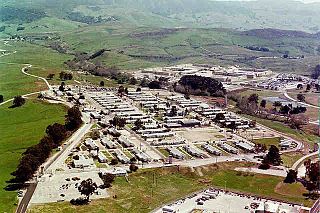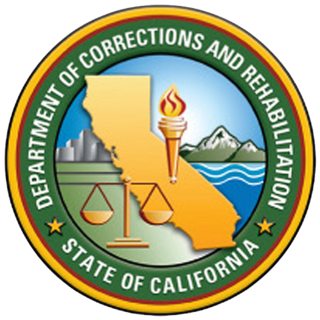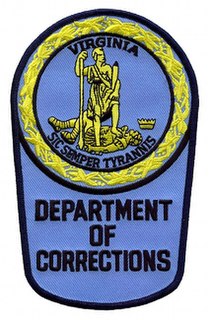
Penology is a sub-component of criminology that deals with the philosophy and practice of various societies in their attempts to repress criminal activities, and satisfy public opinion via an appropriate treatment regime for persons convicted of criminal offences.

California Men's Colony (CMC) is a male-only state prison located northwest of the city of San Luis Obispo, San Luis Obispo County, California, along the central California coast approximately halfway between Los Angeles and San Francisco.

Recidivism is the act of a person repeating an undesirable behavior after they have either experienced negative consequences of that behavior, or have been trained to extinguish that behavior. It is also used to refer to the percentage of former prisoners who are rearrested for a similar offense.

The California Department of Corrections and Rehabilitation (CDCR) is the agency of the government of California responsible for the operation of the California state prison and parole systems. Its headquarters are in Sacramento.
The California Division of Juvenile Justice (DJJ), previously known as the California Youth Authority (CYA), is a division of the California Department of Corrections and Rehabilitation that provides education, training, and treatment services for California's most serious youth offenders. These youths are committed by the juvenile and criminal courts to DJJ's eleven correctional facilities, four conservation camps and two residential drug treatment programs. The DJJ provides services to juvenile offenders, ranging in age from twelve to 25, in facilities and on parole, and works closely with law enforcement, the courts, district attorneys, public defenders, probation offices and other public and private agencies involved with the problems of youth. The DJJ is undergoing reorganization as required by a court agreement and the California State Legislature after widespread criticisms of conditions at its youth prisons. The agency's headquarters are in Sacramento, California.

California Institution for Men (CIM) is a male-only state prison located in the city of Chino, San Bernardino County, California. It is often colloquially referenced as "Chino". In turn, locals call the prison "Chino Men's" or just "Men's" to avoid confusion with the city itself.

The Virginia Department of Corrections (VADOC) is the government agency responsible for community corrections and operating prisons and correctional facilities in the Commonwealth of Virginia in the United States. The agency is fully accredited by the American Correctional Association and is one of the oldest functioning correctional agencies in the United States. Its headquarters is located in the state capital of Richmond.

The New Jersey Department of Corrections (NJDOC) is responsible for operations and management of prison facilities in the U.S. state of New Jersey. The department operates 13 major institutions—seven adult male correctional facilities, three youth facilities, one facility for sex offenders, one women's correctional institution and a central reception / intake unit—and a Stabilization and Reintegration Program. The department is headquartered in Trenton.

Avenal State Prison (ASP) is a male-only state prison in the city of Avenal, Kings County, California, United States.

California Substance Abuse Treatment Facility and State Prison, Corcoran (SATF) is a male-only state prison located in the city of Corcoran, in Kings County, California specifically designed to house inmates who are drug addicts. It is sometimes referred to as California Substance Abuse Treatment Facility, and Corcoran II.
A prison nursery is a section of a prison that houses incarcerated mothers and their very young children. Prison nurseries are not common in correctional facilities in the United States, although prior to the 1950s many states had them and they are widespread throughout the rest of the world.

California State Prison, Centinela (CEN) is a male-only state prison located in Imperial County, California, approximately 20 miles (32 km) from Imperial and El Centro. The facility is sometimes referenced Centinela State Prison.

California Rehabilitation Center (CRC) is a state prison located in Norco, Riverside County, California. The prison is sometimes referenced as "Norco" or "Norco Prison".

California State Prison, Solano (SOL) is a male-only state prison located in the city of Vacaville, Solano County, California, adjacent to the California Medical Facility. The facility is also referenced as Solano State Prison, CSP-Solano, and CSP-SOL.

The Oklahoma Department of Corrections is an agency of the state of Oklahoma. DOC is responsible for the administration of the state prison system. It has its headquarters in Oklahoma City, across the street from the headquarters of the Oklahoma Department of Public Safety. The Board of Corrections are appointees: five members are appointed by the Governor; two members are appointed by the President Pro Tempore of the Senate; and two members are appointed by the Speaker of the house of Representatives. The Board is responsible for setting the policies of the Department, approving the annual budget request, and working with the Director of Corrections on material matters of the agency. Steven Harpe is the current Chairman of the Board. The director, who serves at the pleasure of the Governor, is the chief executive of the Department. The current Interim Director of Corrections is Scott Crow who was appointed after Director Joe Albaugh resigned his post on June 13, 2019.

The California State Prison System is a system of prisons, fire camps, contract beds, reentry programs, and other special programs administered by the California Department of Corrections and Rehabilitation (CDCR) Division of Adult Institutions to incarcerate approximately 117,000 people as of April 2020. CDCR owns and operates 34 prisons throughout the state and operates 1 prison leased from a private company. California "Corrections and Rehabilitation" had a $15.8B budget for the 2019-2020 fiscal year, which was 7.4% of the state budget. The state's prison medical care system has been in receivership since 2006, when a federal court ruled in Plata v. Brown that the state failed to provide a constitutional level of medical care to its prisoners. Since 2009, the state has been under court order to reduce prison overcrowding to no higher than 137.5% of total design capacity.

The Department of Public Safety and Corrections (DPS&C) is a state agency of Louisiana, headquartered in Baton Rouge. The agency comprises two major areas: Public Safety Services and Corrections Services. The Secretary, who is appointed by the Governor, serves as the department's chief executive officer. The Corrections Services Deputy Secretary, Undersecretary, and Assistant Secretaries for the Office of Adult Services and the Office of Youth Development report directly to the Secretary. Headquarters Administration consists of centralized Divisions that support the management and operations of the adult and juvenile institutions, adult and juvenile probation and parole district offices, and all other services provided by the department.
Correctional Training Facility (CTF), commonly referenced as Soledad State Prison, is a state prison located on U.S. Route 101, 5 miles (8.0 km) north of Soledad, California, adjacent to Salinas Valley State Prison.
The Georgia Council on Criminal Justice Reform is a fifteen-member, non-partisan state commission tasked with conducting annual comprehensive reviews of criminal laws, criminal procedure, sentencing laws, adult correctional issues, juvenile justice issues, enhancement of probation and parole supervision, better management of the prison population and of the population in the custody of the Department of Juvenile Justice, and other issues relates to criminal proceedings and accountability courts in the state of Georgia.










